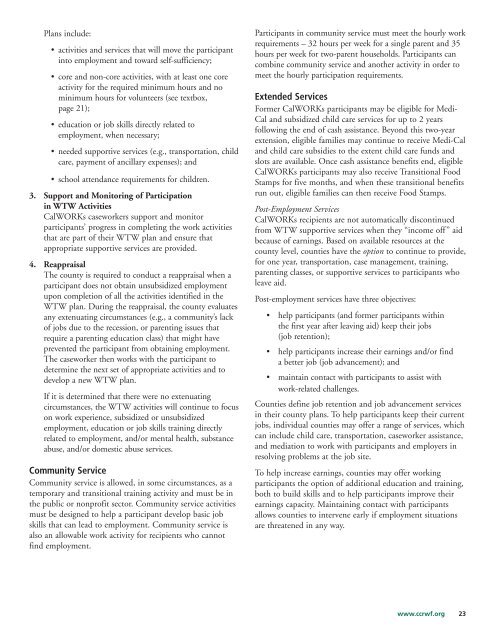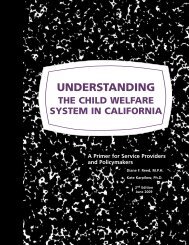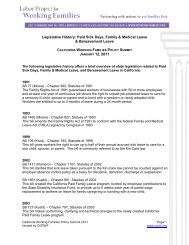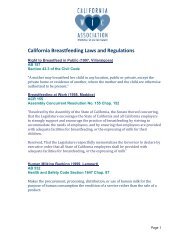<str<strong>on</strong>g>CalWORKs</str<strong>on</strong>g> Employment Services<str<strong>on</strong>g>CalWORKs</str<strong>on</strong>g> employment services include the following:1. orientati<strong>on</strong>, appraisal, and job search;2. assessment and development of the Welfare-to-Work plan;3. support and m<strong>on</strong>itoring of participati<strong>on</strong> inWTW activities; and4. reappraisal and assignment to new activities.1. Orientati<strong>on</strong>, Appraisal, and Job SearchOrientati<strong>on</strong> and appraisal are the initial activities <str<strong>on</strong>g>for</str<strong>on</strong>g> all<str<strong>on</strong>g>CalWORKs</str<strong>on</strong>g> WTW participants.Orientati<strong>on</strong> acquaints participants with the WTWprocess and provides in<str<strong>on</strong>g>for</str<strong>on</strong>g>mati<strong>on</strong> regarding eachparticipant’s rights and resp<strong>on</strong>sibilities.Appraisal involves a face-to-face meeting between theparticipant and a caseworker to discuss the participant’seducati<strong>on</strong>, employment history, and job skills. Duringthis time, the caseworker and participant identifysupportive services needs (like child care ortransportati<strong>on</strong>) that will help the participant with theirjob search, and they develop a plan <str<strong>on</strong>g>for</str<strong>on</strong>g> providing andaccessing the services.Following appraisal, most <str<strong>on</strong>g>CalWORKs</str<strong>on</strong>g> participants areassigned to job search – unless they are exempt(see page 12), already enrolled in a self-initiated trainingor educati<strong>on</strong> program (SIP) (see textbox), or alreadyworking enough hours to meet WTW requirements.Job search/job readiness offers participants employmentservices to help them search <str<strong>on</strong>g>for</str<strong>on</strong>g> and obtain a job.Typically a structured group process to help welfarerecipients find a job, job search is intended to motivateand educate participants, many of whom have limited orno successful employment experience. Job search caninclude training and support <str<strong>on</strong>g>for</str<strong>on</strong>g> resumé writing, basicjob search skills, in<str<strong>on</strong>g>for</str<strong>on</strong>g>mati<strong>on</strong> <strong>on</strong> completing jobapplicati<strong>on</strong>s, mock interviews, and other activities thatprepare participants <str<strong>on</strong>g>for</str<strong>on</strong>g> the job market.The job search phase can last up to 120 or 180 hours ina calendar year, but may be shorter if the participantobtains a job. The county can also extend the jobsearch phase.When serious barriers to employment (e.g., very poorliteracy or language skills, substance abuse, or mentalhealth c<strong>on</strong>diti<strong>on</strong>s) are discovered during the appraisal orjob search stage, the county can move the participantdirectly into <strong>on</strong>e of the next two comp<strong>on</strong>ents describedbelow. Advancing a participant to the next phaseSelf-Initiated ProgramsSome <str<strong>on</strong>g>CalWORKs</str<strong>on</strong>g> participants find educati<strong>on</strong> andtraining programs <strong>on</strong> their own and are enrolled in theprogram prior to the appraisal appointment. Theseprograms, called Self-Initiated Programs (SIPs), aretypically at a community college, adult school, orvocati<strong>on</strong>al school, but may also be at a four-year collegeor university. State law grants SIP recipients up to thefull 60 m<strong>on</strong>ths of <str<strong>on</strong>g>CalWORKs</str<strong>on</strong>g> to finish an educati<strong>on</strong>alprogram. The program must result in a degree orcertificate and lead to employment.The time spent in an individual SIP counts towardsrequired hours of WTW activities. Recipients mustparticipate in the educati<strong>on</strong>al program at least 32 hoursper week. If their classroom, lab, and supervised studytime do not total 32 hours, the participant will be sentto “assessment,” and a WTW plan will be developed <str<strong>on</strong>g>for</str<strong>on</strong>g>the remaining hours. N<strong>on</strong>-credit study time may notcount <str<strong>on</strong>g>for</str<strong>on</strong>g> state participati<strong>on</strong> hours, though it is federallycountable within certain limits.As of October 2009, 6.4 percent of <str<strong>on</strong>g>CalWORKs</str<strong>on</strong>g>recipients who were participating in WTW activitieswere in Self-Initiated Programs.Source: <str<strong>on</strong>g>Cali<str<strong>on</strong>g>for</str<strong>on</strong>g>nia</str<strong>on</strong>g> Department of Social Services. <str<strong>on</strong>g>CalWORKs</str<strong>on</strong>g> Welfare-To-Work M<strong>on</strong>thly Activity Report. Two-Parent Families and All (Other)Families. Released December 24, 2009. Retrieved at: http://www/dss/cahwnet.gov/research/PG292.htm and http://www.dss.cahwnet.gov/research/PG291.htmprovides them with access to educati<strong>on</strong>al programs, suchas English language classes and treatment programs orother services that can increase the participant’s chancesof getting and keeping a job.2. Assessment and Developing the WTW PlanFor participants who do not find a job during job search,state law requires an in-depth assessment, which is a moreintensive analysis of the client’s work history, skills, andneeds than occurs in the appraisal. The assessmentidentifies c<strong>on</strong>diti<strong>on</strong>s that might limit a participant’sability to undertake job search activities or to work. Theassessment also identifies the need <str<strong>on</strong>g>for</str<strong>on</strong>g> educati<strong>on</strong>, training,or other services to prepare the client <str<strong>on</strong>g>for</str<strong>on</strong>g> the work<str<strong>on</strong>g>for</str<strong>on</strong>g>ce.The assessment may be c<strong>on</strong>ducted by a c<strong>on</strong>tractedspecialist or by a caseworker. The results of thisassessment are used to develop a written WTW plan.The WTW plan is essentially a c<strong>on</strong>tract between theparticipant and the county that outlines the activities theparticipant is expected to complete over the comingm<strong>on</strong>ths to meet hourly participati<strong>on</strong> requirements.22 www.ccrwf.org
Plans include:• activities and services that will move the participantinto employment and toward self-sufficiency;• core and n<strong>on</strong>-core activities, with at least <strong>on</strong>e coreactivity <str<strong>on</strong>g>for</str<strong>on</strong>g> the required minimum hours and nominimum hours <str<strong>on</strong>g>for</str<strong>on</strong>g> volunteers (see textbox,page 21);• educati<strong>on</strong> or job skills directly related toemployment, when necessary;• needed supportive services (e.g., transportati<strong>on</strong>, childcare, payment of ancillary expenses); and• school attendance requirements <str<strong>on</strong>g>for</str<strong>on</strong>g> children.3. Support and M<strong>on</strong>itoring of Participati<strong>on</strong>in WTW Activities<str<strong>on</strong>g>CalWORKs</str<strong>on</strong>g> caseworkers support and m<strong>on</strong>itorparticipants’ progress in completing the work activitiesthat are part of their WTW plan and ensure thatappropriate supportive services are provided.4. ReappraisalThe county is required to c<strong>on</strong>duct a reappraisal when aparticipant does not obtain unsubsidized employmentup<strong>on</strong> completi<strong>on</strong> of all the activities identified in theWTW plan. During the reappraisal, the county evaluatesany extenuating circumstances (e.g., a community’s lackof jobs due to the recessi<strong>on</strong>, or parenting issues thatrequire a parenting educati<strong>on</strong> class) that might haveprevented the participant from obtaining employment.The caseworker then works with the participant todetermine the next set of appropriate activities and todevelop a new WTW plan.If it is determined that there were no extenuatingcircumstances, the WTW activities will c<strong>on</strong>tinue to focus<strong>on</strong> work experience, subsidized or unsubsidizedemployment, educati<strong>on</strong> or job skills training directlyrelated to employment, and/or mental health, substanceabuse, and/or domestic abuse services.Community ServiceCommunity service is allowed, in some circumstances, as atemporary and transiti<strong>on</strong>al training activity and must be inthe public or n<strong>on</strong>profit sector. Community service activitiesmust be designed to help a participant develop basic jobskills that can lead to employment. Community service isalso an allowable work activity <str<strong>on</strong>g>for</str<strong>on</strong>g> recipients who cannotfind employment.Participants in community service must meet the hourly workrequirements – 32 hours per week <str<strong>on</strong>g>for</str<strong>on</strong>g> a single parent and 35hours per week <str<strong>on</strong>g>for</str<strong>on</strong>g> two-parent households. Participants cancombine community service and another activity in order tomeet the hourly participati<strong>on</strong> requirements.Extended ServicesFormer <str<strong>on</strong>g>CalWORKs</str<strong>on</strong>g> participants may be eligible <str<strong>on</strong>g>for</str<strong>on</strong>g> Medi-Cal and subsidized child care services <str<strong>on</strong>g>for</str<strong>on</strong>g> up to 2 yearsfollowing the end of cash assistance. Bey<strong>on</strong>d this two-yearextensi<strong>on</strong>, eligible families may c<strong>on</strong>tinue to receive Medi-Caland child care subsidies to the extent child care funds andslots are available. Once cash assistance benefits end, eligible<str<strong>on</strong>g>CalWORKs</str<strong>on</strong>g> participants may also receive Transiti<strong>on</strong>al FoodStamps <str<strong>on</strong>g>for</str<strong>on</strong>g> five m<strong>on</strong>ths, and when these transiti<strong>on</strong>al benefitsrun out, eligible families can then receive Food Stamps.Post-Employment Services<str<strong>on</strong>g>CalWORKs</str<strong>on</strong>g> recipients are not automatically disc<strong>on</strong>tinuedfrom WTW supportive services when they “income off” aidbecause of earnings. Based <strong>on</strong> available resources at thecounty level, counties have the opti<strong>on</strong> to c<strong>on</strong>tinue to provide,<str<strong>on</strong>g>for</str<strong>on</strong>g> <strong>on</strong>e year, transportati<strong>on</strong>, case management, training,parenting classes, or supportive services to participants wholeave aid.Post-employment services have three objectives:• help participants (and <str<strong>on</strong>g>for</str<strong>on</strong>g>mer participants withinthe first year after leaving aid) keep their jobs(job retenti<strong>on</strong>);• help participants increase their earnings and/or finda better job (job advancement); and• maintain c<strong>on</strong>tact with participants to assist withwork-related challenges.Counties define job retenti<strong>on</strong> and job advancement servicesin their county plans. To help participants keep their currentjobs, individual counties may offer a range of services, whichcan include child care, transportati<strong>on</strong>, caseworker assistance,and mediati<strong>on</strong> to work with participants and employers inresolving problems at the job site.To help increase earnings, counties may offer workingparticipants the opti<strong>on</strong> of additi<strong>on</strong>al educati<strong>on</strong> and training,both to build skills and to help participants improve theirearnings capacity. Maintaining c<strong>on</strong>tact with participantsallows counties to intervene early if employment situati<strong>on</strong>sare threatened in any way.www.ccrwf.org23










